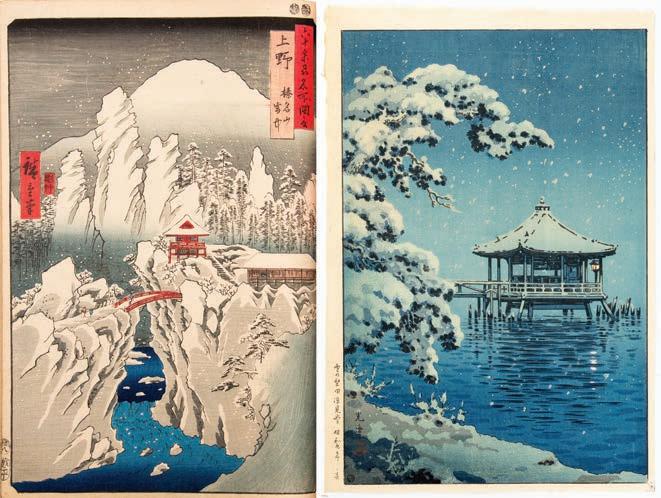
2 minute read
JAPANESE WORKS OF ART
Opposite:
A massive wood articulated model of a snake by Masakazu, 19th century, 175cm
Advertisement

Estimate £12,000–15,000
A netsuke of a chameleon by Michael Webb (1934–2011), 6cm
Estimate £600–800
Above:
A large Japanese Arita dish, c.1670–80, 53.5cm
Estimate £12,000–15,000
A rare Japanese apothecary jar, c.1650, 27.3cm
Estimate £5,000–8,000
Below:
Tsuchiya Koitsu (1870–1949), c.1929, ‘Snow at Ukimido, Katada’, 36.5 X 24.5cm
Estimate £400–600
Porcelain For Palaces
The November 2022 Japanese sale included the collection of Dr Oliver Impey (1936–2005), Senior Curator at the Ashmolean Museum in Oxford. A renowned authority on early Japanese ceramics, the collection featured many 17th century pieces. The May 2023 sale will include further examples of early Japanese porcelain, and in particular, hybrid pieces produced for the West.
When Chinese kilns ground to a halt following the collapse of the Ming Dynasty in the 1640s, Japan soon became the main source of porcelain for the West. These early pieces were decorated in Western style, sometimes featuring shapes inspired by European pottery or silverware. At 53.5cm, this massive dish (top left) is an impressive example. Such large pieces were produced in small numbers due to the high risk of damage during firing. Japanese porcelain was extremely popular in Western courts, and a pair of related dishes can be found today in the Royal Collection Trust.

The apothecary jar illustrated top left is an unrecorded and possibly unique example. The shape is based on the European albarello (probably from the Arabic term al barani, meaning storage), a container used for spices, herbs and other medicinal products. The European model derived from Persian and Syrian jars from the 12th–13th century. This Japanese example dates from c.1650 and was made as a special order. The depiction of a male harpy wearing a neck ruff is very unusual, and it may have been the armorial used by a particular monastery or apothecary.
A Japanese Menagerie
From birds with human heads to gigantic snakes: these are a few examples of the wide range of fantastical beasts in the sale. Mythological creatures and animals are ubiquitous in Japanese art, and this fully articulated wood carving of a snake opposite is one of the most impressive creatures in this sale. At 175cm long, it also features mother of pearl fangs and inlaid pupils. Ophidiophobia sufferers may prefer the selection of netsuke also on offer including pieces by artist Michael Webb (1934–2009), such as this charming chameleon.
SHIN-HANGA : A NEW KIND OF WOODBLOCK PRINTS

The November auction confirmed the growing popularity of the Shin-Hanga style of woodblock prints, with the sale of a private collection of bird pictures flying away to international buyers. Literally meaning ‘new prints’, the Shin-Hanga movement emerged during the Taisho era (1912–26). This innovative approach was meant to revive Japanese printmaking, which had been dominated by the traditional ukiyo-e style since the 17th century. Inspired by Impressionism and other European art, it is characterised by bright colours, Western compositions, and modern viewpoints. The sale will feature many examples from both genres, including this print by Tsuchiya Koitsu.
Alexandra Aguilar
+44 (0)1722 424583 | aa@woolleyandwallis.co.uk
Our Japanese sale will be divided in two parts: Fine Japanese Works of Art on the morning of 23rd will feature high-quality collectables, and Japanese Art II in the afternoon will include more affordable and decorative pieces. Please contact the department for more information.










